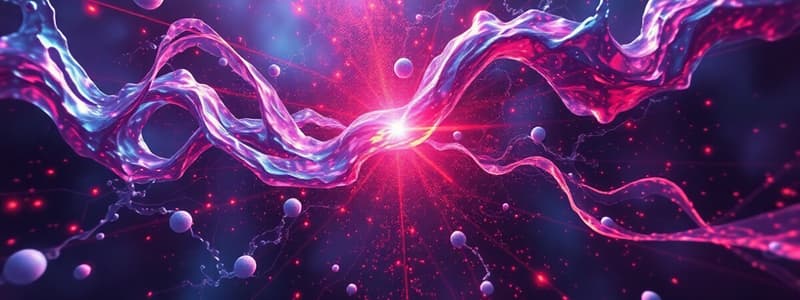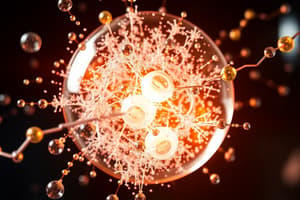Podcast
Questions and Answers
¿Qué deben tener las partículas para que ocurra una reacción según la teoría de las colisiones?
¿Qué deben tener las partículas para que ocurra una reacción según la teoría de las colisiones?
- Solo orientación adecuada
- Orientación adecuada y energía necesaria (correct)
- Solo energía cinética
- Alta velocidad y baja concentración
¿Qué es la energía de activación?
¿Qué es la energía de activación?
- Energía necesaria para pasar de reactivos a productos (correct)
- Energía liberada durante una reacción exotérmica
- Energía absorbida durante una reacción endotérmica
- Energía necesaria para construir un catalizador
¿Qué factores aumentan las colisiones en una reacción?
¿Qué factores aumentan las colisiones en una reacción?
- Uso de inhibidores
- Alta concentración y alta velocidad (correct)
- Baja concentración y baja velocidad
- Disminución de la temperatura
¿Qué afecta la superficie de contacto en reacciones?
¿Qué afecta la superficie de contacto en reacciones?
¿Qué se reduce al disminuir el tamaño de las partículas en estado sólido?
¿Qué se reduce al disminuir el tamaño de las partículas en estado sólido?
¿Qué efecto tiene generalmente el aumento de temperatura en la velocidad de una reacción?
¿Qué efecto tiene generalmente el aumento de temperatura en la velocidad de una reacción?
¿Qué son los catalizadores?
¿Qué son los catalizadores?
¿Qué ocurre cuando se aumenta la velocidad de una reacción disminuyendo la energía de activación?
¿Qué ocurre cuando se aumenta la velocidad de una reacción disminuyendo la energía de activación?
¿Qué caracteriza una reacción exotérmica en términos de productos?
¿Qué caracteriza una reacción exotérmica en términos de productos?
¿Qué caracteriza una reacción endotérmica?
¿Qué caracteriza una reacción endotérmica?
Para que las partículas reaccionen, ¿qué dos condiciones deben cumplirse según la teoría de colisiones?
Para que las partículas reaccionen, ¿qué dos condiciones deben cumplirse según la teoría de colisiones?
¿Qué rol juegan los catalizadores en una reacción química?
¿Qué rol juegan los catalizadores en una reacción química?
En una reacción, ¿cómo afecta el aumento de la concentración de los reactivos la velocidad de reacción?
En una reacción, ¿cómo afecta el aumento de la concentración de los reactivos la velocidad de reacción?
¿Qué sucede con la velocidad de una reacción cuando se disminuye la temperatura?
¿Qué sucede con la velocidad de una reacción cuando se disminuye la temperatura?
¿Cómo influye el estado físico (sólido, líquido, gas) de los reactivos en la velocidad de reacción?
¿Cómo influye el estado físico (sólido, líquido, gas) de los reactivos en la velocidad de reacción?
¿Cuál es el efecto de un catalizador sobre la energía de activación de una reacción?
¿Cuál es el efecto de un catalizador sobre la energía de activación de una reacción?
En una reacción endotérmica, ¿la energía de los productos es generalmente mayor o menor que la de los reactivos?
En una reacción endotérmica, ¿la energía de los productos es generalmente mayor o menor que la de los reactivos?
¿Cómo se puede aumentar la velocidad de una reacción en fase sólida?
¿Cómo se puede aumentar la velocidad de una reacción en fase sólida?
¿Cómo afectan los catalizadores a la velocidad de una reacción química?
¿Cómo afectan los catalizadores a la velocidad de una reacción química?
Si una reacción libera calor, ¿cómo se clasifica?
Si una reacción libera calor, ¿cómo se clasifica?
Flashcards
Collision Theory
Collision Theory
For a reaction to occur, particles must collide, but not all collisions create new molecules. Particles must have adequate orientation and energy.
Activation Energy (Ea)
Activation Energy (Ea)
The minimum energy required to transform reactants into an activated complex, which is at neither reactant nor product stage.
Concentration and Velocity
Concentration and Velocity
Higher concentration and increased velocity mean more collisions.
State of Matter & Collisions
State of Matter & Collisions
Signup and view all the flashcards
Particle Size & Contact
Particle Size & Contact
Signup and view all the flashcards
Temperature & Velocity
Temperature & Velocity
Signup and view all the flashcards
Catalysts
Catalysts
Signup and view all the flashcards
Catalyst's Effect
Catalyst's Effect
Signup and view all the flashcards
Exothermic Reaction
Exothermic Reaction
Signup and view all the flashcards
Endothermic Reaction
Endothermic Reaction
Signup and view all the flashcards
Study Notes
- Collision Theory explains how chemical reactions occur
- For a reaction to occur, particles must collide
- Not all collisions create new molecules
Effective Collisions Require:
- Adequate orientation of the particles
- Necessary energy to form an activated complex
Activated Complex
- The point in the collision where reactants transition into products
- Activation energy (Ea) is required to take reactants to activated complex
Factors Affecting Reaction Rate
- Concentration increases collisions and velocity increases
- More molecules and collisions increase the rate
- Surface area increases collisions
- Gases or liquids have increased collisions
Particle Size
- Solids with reduced size increases contact
- Higher temperatures increases velocity and collisions
Catalysts
- Catalysts affect the speed of a reaction without being reactants or products
- Catalysts are specific
- Catalysts increase velocity, enough with a small quantity
- Catalysts increase reaction velocity by decreasing activation energy (EA)
- Catalysts decrease reaction velocity by raising activation energy (EA)
Reaction Heat
- Exothermic reactions release heat during product formation
- Endothermic reactions absorb heat during product formation
Studying That Suits You
Use AI to generate personalized quizzes and flashcards to suit your learning preferences.


